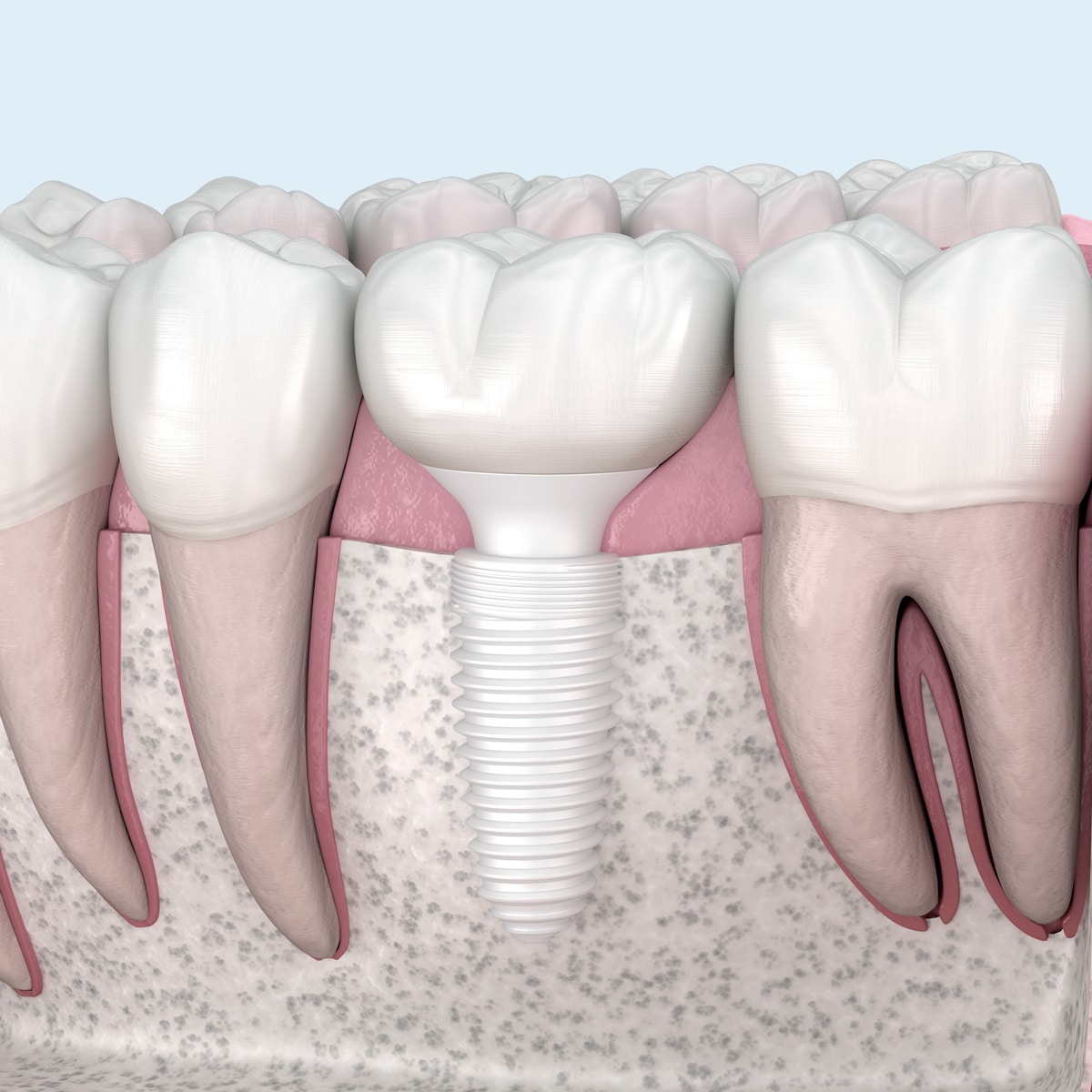Ceramic implants
The DR. HAGER | dentists are pioneers in the field of ceramic implants. Dr. med. dent. Michael Hager (student of the inventor Prof. Sandhaus, Lausanne) placed his first ceramic implant in 2002, at a time when only a handful of implantologists worldwide were doing the same. The success story of this biocompatible high-performance material continues to this day, not only in dentistry but also in medicine, and reflects people’s current awareness of immunological, biological and therefore health-friendly solutions.
- 3 Implant specialists DZGI© (unique in Germany)
- Over 20,000 implants placed (ceramic and titanium)
- Fixed price guarantee for all implant treatment offers
- Family practice for 40 years, now in its 2nd generation

Certified specialist practice for implantology
Our practice is certified as an implantology specialist practice by the German Society for Implantology(DGI) and Germany’s oldest implant society for implantology, the DGZI. We carry out almost 1,000 dental implantations and bone augmentation operations (augmentations) on an outpatient basis every year.

Ceramic dental implants
The Swiss dental implantologist Prof. S. Sandhaus in Lausanne introduced metal-free ceramic implants made of zirconium oxide to dentistry back in the 1990s.
He and Prof. W. Schulte, Tübingen, were the pioneers of ceramic implants at a time when titanium implants were also only at the beginning of their development. Dr. med. dent. Michael Hager, a student of Prof. S. Sandhaus, was already gaining clinical experience with the Sigma implants developed by Sandhaus at a time when new developers of ceramic implants were increasingly motivated by the success of these zirconium oxide implants. These experiences with Prof. S. Sandhaus were to have a lasting impact on Dr. HAGER’s practice and its treatment concept.
Today, there are many manufacturers of ceramic implants, all of whom use the material zirconium oxide in modified forms, which was introduced to implantology by Prof. Sandhaus. DR. HAGER dentists also use this material in their own product line with bacteria-proof bonded screw-free crown abutments that sit on the ceramic implants. This system is therefore one of the few on the market that has succeeded in doing so with this design. Only the patients of DR.HAGER | Zahnärzte are the exclusive beneficiaries of this patented achievement.
Read more
Research is currently focusing on the manufacture of two-part ceramic implants:
Titanium implants are usually two-part implants, i.e. the implant heals under the mucous membrane, protected from premature loading, and the second part is only screwed into the implant after it has healed firmly into the jawbone to accommodate the dental crown. This screwing in is not easily possible with ceramics, as no screw works in ceramics (problem of avoiding tensile stress, see below).
Therefore, until recently, only so-called one-piece ceramic implants were available, but these are at risk of loss due to the threat of premature loading in the mouth. Nevertheless, the advantages are obvious and there are many good reasons to opt for ceramic implants.

The prosthetic restoration is the visible part of the dental prosthesis that is placed on the abutment. This can be a single crown or a fixed bridge. The ceramic is tooth-colored and highly aesthetic.
Exclusively with ceramic implants, the implant body heals visibly and must not be loaded during healing. The gums grow onto it.
The threads of the ceramic implants have a special shape to ensure that the bone grows in. They are also biologically neutral and are often chosen by patients for this very reason.
Ceramic implant or titanium implant?
These are the seven advantages of zirconium oxide:
1. Particularly sensitive patients with a pronounced tendency to allergies, for example, fear that the use of metal dental implants made of titanium will place a higher burden on the immune system. Studies do indeed appear to show an increased intolerance to titanium in certain patients. Avoiding metal for implants by using ceramic as an alternative is a good way to still benefit from the advantages of implant therapy. Ceramic implants are a valuable component of holistic dentistry due to their tolerability.
2. if the optically dark metal titanium is used, under unfavorable conditions (e.g. thin gums) the gums above the implant may appear darker. A titanium implant looks particularly unattractive in the visible area of the front teeth. The light color of the ceramic implant is a clear aesthetic advantage here.
Read more
3. the accumulation of bacterial films on the implant surface is significantly higher with titanium or even surgical PEEK resins than with teeth. The zirconium oxide surfaces of ceramic implants show a significantly lower adhesion of bacterial plaque, even compared to teeth.
4. As with the tooth surface, the gums grow firmly and coherently onto the ceramic surface of the implant, leaving no gap between the implant material and the gums. Patients benefit from the improved biocompatibility of ceramic implants.
5. All common surgical procedures for dental implants are also possible with ceramic implants. The surgeon’s procedure differs from that for titanium implants and requires a great deal of experience in handling ceramic implants. However, if the special treatment rules are followed, zirconia implants are in no way inferior to titanium implants in terms of durability and stability. All prosthetic restorations such as crowns, bridges and dentures are possible.
6. the healing times for implantation in the jawbone appear to be shorter with ceramic implants. In terms of its physical surface properties, the material is even more bone-friendly than titanium, which is already very well tolerated. The risk of inflammation after implantation is also reduced due to the organism-friendly properties of ceramic implants.
7. With the metal-free ceramic implants, it is now actually possible to provide our patients with completely metal-free dental care with fixed dentures, because we place metal-free crowns and bridges, which are also made of zirconium oxide, on the ceramic implants. The zirconium oxide dentures are produced using CAD-CAM computer milling in our own laboratories in Bietingen and Constance by our experienced dental technicians who have been working there for many years.

Find out more about our practice in our patient interviews

“In recent years in particular, dentistry has turned very strongly towards ceramic implants. At Dr. Hager, we have not only been using ceramic implants for over 10 years, but have also been conducting research in this field. As a result, our patients benefit greatly from this advance in knowledge and experience.”
Dr. Michael Hager
How does implantation with ceramic implants work?

Cost-effective initial examination and consultation
In order to determine the appropriate therapy with the patient during the examination, various parameters need to be analyzed. If an implant is considered, the bone quality, the type of existing tooth gap and the bone quantity are examined in detail.
Innovative software is available to help prepare the diagnosis in a way that patients can understand using sample images and videos. This enables live planning with a final treatment offer to be drawn up with a fixed time and cost plan, all with the DR. HAGER fixed price guarantee.
Patients can then discuss the situation with their relatives at home using all the printed drawings and pictures from their own treatment folder.

The implantation
One or more implants are placed at this appointment. The implantologists at DR.HAGER | Zahnärzte have the latest equipment at their disposal, which is required to perform an implantation in a minimally invasive, highly precise and safe manner.
Thanks to a careful (specially developed injection technique) and generous anesthesia, there is no pain during the operation.
After a detailed bone analysis, the ceramic implant is then inserted with a steady hand. After a final X-ray, the patient can leave the practice.
In order not to jeopardize the healing of the ceramic implants, clear instructions are given to the patient. This is followed by the healing phase of 8-12 weeks.

Impression after healing phase
After checking the implants for strength, they are now prepared for the impression.
This is aided by the state-of-the-art 3D scanner, which records the exact situation so that the dental technicians in the DR. HAGER | dental laboratory can produce a highly esthetic and precisely fitting ceramic crown.
The appointment is often surprisingly quick for patients, but for us dentists and dental technicians it is a crucial one.

The crown is inserted
Today is a special day, because the elaborately manufactured ceramic dentures are firmly attached to the zirconium implants.
A special dental cement is used to fix the crown or bridge firmly to the zirconia implant.
Finally, the daily cleaning is demonstrated to the patient and the aftercare procedure is explained.
Comprehensive initial examinations at a reasonable price, including a personal treatment folder with a fixed price offer
In a non-binding consultation, you will find out which treatments are necessary for you. At our practices in Constance and Bietingen near Schaffhausen, we offer complete solutions including dental implants and dentures. With our experience from over 50,000 treated patients, we will create a treatment plan tailored to your needs. This offer comes with a price guarantee.
You will be informed about the treatment steps, risks, costs and duration of treatment. 3D scans, photos and X-ray images illustrate the treatment process and are included in the printed treatment folder.

Initial examination + free fixed price offer.
This is how dentists work today.

Ceramic implants made from the dentally approved material zirconium oxide
The ceramic zirconium dioxide, or zirconium oxide for short, is extracted from natural zircon sand deposits, primarily in Asia and Australia. After intensive cleaning processes, the material is approved for surgical and dental ceramic implants in accordance with the international ISO standard 13356 (2008).
Increased radioactivity is mentioned in early statements. After the purification of hafnium impurities, this is finally eliminated. The accusation that zircon is, after all, a metal does not apply either, as it is the oxide of zircon, not the metal zircon itself. Similarly, common salt (sodium chloride), for example, is a salt and not a metal (like the metal sodium).
Read more
The modifications that have been developed since the 1990s have increased the fracture strength and long-term resistance in the body’s environment in particular, creating an ideal material for long-lasting ceramic implants and zirconium oxide dentures.
Additions of aluminum oxide, yttrium and dyes, as well as the introduction of high-temperature presses HIP, process variants in the final processing resulted in today’s standard, which is achieved by all ceramic systems in approximately the same way.
However, DR.HAGER dentists have reservations about the use of screw-fixed crown abutments on ceramic implants, regardless of the screw material. This is because every screw causes tensile stress on the ceramic, for which only metals, but not ceramics, are suitable. The consequences of the tensile stress can be seen in chipping at the edge of the implant, which inevitably leads to the loss of the implant. Dentists use bonded crowns to avoid exposing ceramic implants to tensile stress.
International research is paying particular attention to the design of the surface of ceramic implants. Optimal roughness values have now been confirmed by research; these values are also achieved by all current brands and even exceed those of other manufacturers according to independent SEM (scanning electron microscope) examinations. The DR. HAGER | dentists are naturally proud to be able to offer this exclusively to their patients.
If you leave gaps in your teeth
Reasons for closing gaps after tooth loss
If a tooth is lost, a gap is created. Many people then ask themselves, can I just leave the gap as it is or should I get a replacement?There are many important reasons to replace a lost tooth as soon as possible, and not just for aesthetic reasons. The greatest danger is the change in bite from the upper jaw to the lower jaw. The dentist refers to this as parafunction. This change is often accompanied by far-reaching problems. The new bite situation is often strained at night by constant grinding and pressing over tooth cusps. This can result in multiple problems: Neck pain, migraines, tension headaches and many more. If this situation can manifest itself for a long time, correction becomes increasingly necessary.

If you leave gaps in your teeth
Reasons for closing gaps after tooth loss
Further consequences are If the bite is unfavorable, the adjacent teeth tilt into the gap and thus dissolve the important contact point to the next neighbor. Food residue often gets caught in the small opening between the teeth and attempts are made to remove this residue using household remedies. Many people injure their gums in the process, resulting in an infection of the gums. If there is no solution in sight, the gums and bone recede. Loose teeth are a late consequence.

If you leave gaps in your teeth
Reasons for closing gaps after tooth loss
Another not insignificant reason for closing a tooth gap is that leaving the tooth gap would cause the antagonist (the opposite tooth) to move into the gap. This lengthens the tooth and interrupts the chewing plane. This creates an obstacle during the chewing movement with which the other teeth rub and wear. This parafunction with much more far-reaching consequences is again the muscular tension in the chewing muscles, back muscles and neck muscles. Tension headaches and migraines are just some of the associated symptoms.

If you leave gaps in your teeth
Reasons for closing gaps after tooth loss
It can also have consequences for the digestive system. Missing teeth in the posterior region in particular prevent food from being chopped up properly, as the posterior teeth are in the so-called chewing area. If food is not cut up properly, the digestive system is overloaded. Excessively large pieces of food are transported towards the stomach. The result is chronic overloading of the stomach and intestines. The consequences can be far-reaching and are potential causes of cell degeneration (cancer).

Make an appointment with the
specialists for ceramic implants
DR. HAGER | dentists in Constance and Bietingen near Schaffhausen, will inform you on site about the advantages and costs of ceramic implants and share with you the many years of experience of implantologists and prosthodontists with dental prostheses and dental implants made of zirconium oxide. We look forward to your visit!

and the entire Dr Hager team

Frequently asked questions about ceramic implants
We will be happy to advise you personally in a free initial consultation (possibly €60 OPG). An offer with a fixed price guarantee will be printed out during the consultation and given to you and your family for the consultation at home.
With good care it is like a new tooth, the implant cannot get caries, but like around natural teeth, the gums can also become inflamed.
There are no intolerances or allergic reactions. The gums attach more tightly to ceramic implants than with titanium implants.
For example, if the bone and mucous membrane in the front are very thin and metal could shimmer through darkly. Also if the patient has an aversion to titanium/metal implants.
The implants are inserted painlessly into a pre-drilled shaft in the bone.
This depends on the individual scope and situation. In most cases, this takes approx. 1 hour per implant.
No. We need at least one impression at an appointment. However, the impression is usually made in the form of a 3D scan. This is more convenient for patients.
Yes, all implantologists are specially trained.
High demands are placed on the patient’s cooperation during the healing of zirconium oxide implants:
The ceramic implants protrude approx. 2 mm from the gums during the healing phase. eight weeks of consistent chewing.
Only a few long-term studies are available, but ongoing studies (including our own study) indicate that ceramic implants are very durable and long-lasting.
The higher cost of ceramic implants compared to titanium implants is justified by the tolerable properties of ceramic implants, which are usually inserted and heal without complications and minimize the risk of inflammation thanks to the metal-free material.
The healing time for ceramic implants in the jawbone is slightly longer than that of titanium implants. In terms of its physical surface properties, the material is even more bone-friendly than titanium, which is already very well tolerated. However, experience has shown that it takes a little longer to insert into the bone.
The risk of inflammation after implantation is also reduced due to the organism-friendly properties of ceramic implants.
For patients with metal intolerance and/or esthetically critical mucosa/bone conditions.